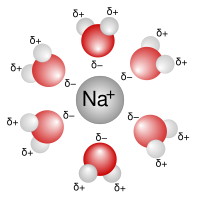
Photo from wikipedia
Activated carbon (AC) was prepared from carbonization of phosphoric acid soaked peanut shell at 380°C under inert atmosphere followed by activation with hydrogen peroxide. The AC was characterized by SEM,… Click to show full abstract
Activated carbon (AC) was prepared from carbonization of phosphoric acid soaked peanut shell at 380°C under inert atmosphere followed by activation with hydrogen peroxide. The AC was characterized by SEM, EDX, FTIR, TGA, and BET surface area and pore size analyzer. The potential of AC as a catalyst for solvent-free oxidation of cyclohexane to cyclohexanol and cyclohexanone (the mixture is known as KA oil) in the presence of molecular oxygen at moderate temperature was investigated in a self-designed double-walled three-necked batch reactor. The effect of different reaction parameters/additive was optimized. The maximum productivity value (2.14 mmolg−1 h−1, without base, and 4.85 mmolg−1 h−1, with 0.2 mmol NaOH) of the desired product was achieved under optimal reaction parameters: vol 12.5 mL, cat 0.4 g, time 14 h, oxygen flow 40 mL/min (pO2 760 Torr), stirring 1100 rpm, and temp 75°C. The AC shows recyclability for multiple runs without any significant loss in activity. Thus, the AC can be an efficient catalyst, due to low cost, ease of synthesis, easy recovery, nonleaching, and recyclability for multiple uses for the solvent-free oxidation of cyclohexane.
Journal Title: Journal of Chemistry
Year Published: 2017
Link to full text (if available)
Share on Social Media: Sign Up to like & get
recommendations!